They show where the nation has been growing since the April 2010 Census headcount, a period that follows the end of the 2007-2009 recession and includes three-fourths of the Obama presidency. They show what states Americans have been moving in and out of, and what states have attracted the most immigrants.
They're worth looking at, because the cold precision of the numbers provides clues to the warm impulses of human hearts, where people choose to pursue dreams or escape nightmares.
During this five-year period the nation's population increased from 308.8 million to 321.4 million, which sounds like a lot -- we're the third-most-populous nation in the world -- but in fact is slightly lower in percentage terms than any such period since the 1930s.
Growth was highly uneven. The biggest percentage growth rates were in fracking-rich North Dakota (13 percent), the gentrifying District of Columbia (12 percent) and the much bigger states of Texas (9 percent), Colorado, Utah and Florida (8 percent). The big percentage gainers of the 2000-2010 decade, Nevada and Arizona, gained at lesser rates this decade, as did Georgia, the Carolinas and Virginia.
Altogether 45 percent of the nation's population growth occurred in the three Sun Belt states: Texas, California and Florida. But it was from quite different sources. In Texas and Florida, there was more net migration from other states -- domestic inflow -- than immigration. This was true also of the fast-growing North Carolina, South Carolina, Colorado, Arizona, Nevada and Washington.
Recommended
Political analysts in the last decade predicted that heavy immigration would make these states more Democratic. But in this decade it looks like any such movement will depend more on domestic migrants, who seem Democratic-leaning in some states (Washington and North Carolina) but not others (Texas, Florida, South Carolina and Arizona).
In any case, as the Pew Research Center has documented, there has been no net immigration from Mexico since 2008; incomers have been matched by those who "self-deport." That finds confirmation in the 2015 estimates, which show immigration numbers in 2010-2015 sharply lower than in 2000-2008 in states that have had heavy Mexican inflows: California, Nevada, Arizona, Colorado, Texas and Illinois.
Immigration in this decade has exceeded the national rate in only 12 states and D.C., with the highest rates in Florida and the Northeast (D.C., New York, New Jersey, Massachusetts, Maryland, Connecticut and Virginia).
In these states and in California and Washington, immigrants seem to be increasingly Asians, many with high skill levels, rather than Latinos, almost all relatively low-skill. Those of us who have urged revising immigration law to favor high-skill newcomers are apparently seeing something like that result produced by market forces under current law.
The high-immigration states plus Illinois have had the nation's highest rates of domestic outflow, reflecting high tax rates, heavy regulation and high housing prices. In effect, they're trading Americans for immigrants, the political result of which is a tendency to make these states even more heavily Democratic.
This is apparent when you group states by political tendency. The 23 Republican states have grown 5.1 percent in 2010-2015, the 11 target states 4.2 percent and the 16 Democratic states plus D.C. 3.2 percent. (I classify Colorado, Florida, Iowa, Nevada, New Hampshire, New Mexico, North Carolina, Ohio, Pennsylvania, Virginia and Wisconsin as target states. You can probably guess which of the others are Republican and Democratic.)
Republican states gained 2.3 million newcomers, split evenly between immigration and domestic inflow. Target states gained 2.0 million, two-thirds from immigration and one-third from domestic inflow. In contrast, the Democratic states lost 1.8 from domestic outflow but gained 2.8 million immigrants -- more than half the national immigration total.
Overall, population increase and mobility are both down from the previous decade; people tend to hunker down in straitened economic times. Annual immigration numbers remained about the same in 2010-2015 as 2000-2008, but for those earlier years they probably understate the flow of illegal immigrants, which seems to have been much larger then than recently.
But the tendency is continuing for Americans and immigrants to seek out others of their own kind, and for people of differing cultural values and political views to choose to live in different states and communities. All of which suggests that today's political polarization is not going away any time soon.

























Join the conversation as a VIP Member